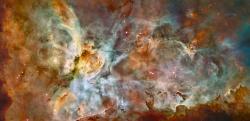 It’s hard to believe, but the Hubble Space Telescope has been churning out discovery after discovery for 17 years now. To celebrate the anniversary, NASA and ESA released a high-resolution image taken by Hubble of the Carina Nebula. And what a photograph!
It’s hard to believe, but the Hubble Space Telescope has been churning out discovery after discovery for 17 years now. To celebrate the anniversary, NASA and ESA released a high-resolution image taken by Hubble of the Carina Nebula. And what a photograph!
Continue reading “Hubble’s Detailed Photograph of the Carina Nebula”
Black Holes Could Provide the Seeds of Life
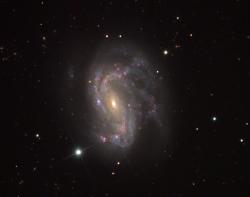 You’ve heard it all before. Black holes pull with a gravity so strong that nothing, not even light, can escape. You would think that black holes are the place where everything goes to die, but it might be possible that black holes are the source of life as well.
You’ve heard it all before. Black holes pull with a gravity so strong that nothing, not even light, can escape. You would think that black holes are the place where everything goes to die, but it might be possible that black holes are the source of life as well.
Continue reading “Black Holes Could Provide the Seeds of Life”
Podcast: The Search for Neutrinos
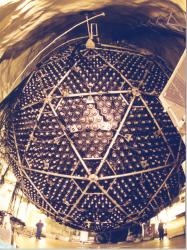 Trillions of neutrinos are produced in our Sun through its nuclear reactions. These particles stream out at nearly the speed of light, and pass right through any matter they encounter. In fact, there are billions of them passing through your body right now. Learn how this elusive particle was first theorized and finally discovered.
Trillions of neutrinos are produced in our Sun through its nuclear reactions. These particles stream out at nearly the speed of light, and pass right through any matter they encounter. In fact, there are billions of them passing through your body right now. Learn how this elusive particle was first theorized and finally discovered.
Continue reading “Podcast: The Search for Neutrinos”
What’s Up this Week: April 16 – April 22, 2007
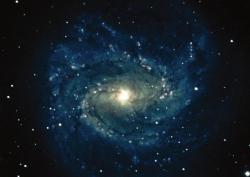 Monday, April 16 – Before binocular observers begin to feel that we have deserted them, let’s drop in on a binocular and very small telescope galaxy that resides roughly a handspan below Spica – M83. Starhop instructions are not easy for this one, but look for a pair of twin stars just west of the easily recognized “box” of Corvus – Gamma and R Hydrae. You’ll find it about four fingerwidths further south of R.
Monday, April 16 – Before binocular observers begin to feel that we have deserted them, let’s drop in on a binocular and very small telescope galaxy that resides roughly a handspan below Spica – M83. Starhop instructions are not easy for this one, but look for a pair of twin stars just west of the easily recognized “box” of Corvus – Gamma and R Hydrae. You’ll find it about four fingerwidths further south of R.
Continue reading “What’s Up this Week: April 16 – April 22, 2007”
Podcast: String Theory, Time Travel, White Holes, Warp Speed, Multiple Dimensions, and Before the Big Bang
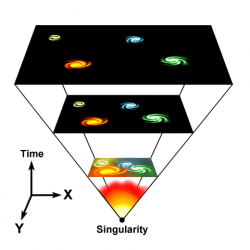 We get questions every week about string theory and topics popularized by science fiction. Here’s the problem. There’s just no evidence. Each of these is based on wonderful and well-formed mathematical equations, or wishful thinking, but they’re very hard (if not impossible) to test in the real Universe.
We get questions every week about string theory and topics popularized by science fiction. Here’s the problem. There’s just no evidence. Each of these is based on wonderful and well-formed mathematical equations, or wishful thinking, but they’re very hard (if not impossible) to test in the real Universe.
Continue reading “Podcast: String Theory, Time Travel, White Holes, Warp Speed, Multiple Dimensions, and Before the Big Bang”
Podcast: The Sun, Spots and All
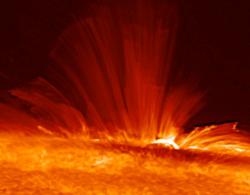 It’s Spring in the Northern Hemisphere, and that means the Sun is back. But it’s more than just a free heat lamp for your garden, it’s an incredible, dynamic nuclear reaction complete with flares, coronal mass ejections, twisting magnetic fields and the solar wind. Put in your headphones, head outside and enjoy the sunshine while you listen to this week’s podcast.
It’s Spring in the Northern Hemisphere, and that means the Sun is back. But it’s more than just a free heat lamp for your garden, it’s an incredible, dynamic nuclear reaction complete with flares, coronal mass ejections, twisting magnetic fields and the solar wind. Put in your headphones, head outside and enjoy the sunshine while you listen to this week’s podcast.
Continue reading “Podcast: The Sun, Spots and All”
Observatories Get the Jump on Gamma Ray Bursts
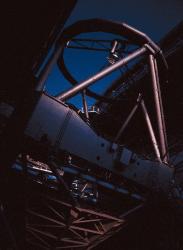 Even though gamma ray bursts are the most powerful known explosions in the Universe, you’ve got to move quickly if you want to capture useful science from them. A new press release from the European Southern Observatory goes into detail about how they work quickly to catch a burst’s fading light.
Even though gamma ray bursts are the most powerful known explosions in the Universe, you’ve got to move quickly if you want to capture useful science from them. A new press release from the European Southern Observatory goes into detail about how they work quickly to catch a burst’s fading light.
Continue reading “Observatories Get the Jump on Gamma Ray Bursts”
Hexagonal Structure at Saturn’s North Pole
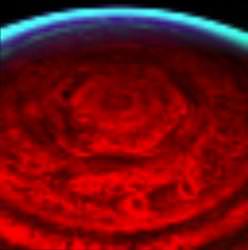 New Cassini infrared images of Saturn have revealed one of its strangest features – a bizarre six-sided cloud structure circling the entire north pole. This structure was hinted at when the Voyager spacecraft first visited the planet more than 20 years ago, but the new images from Cassini really show the structure in detail.
New Cassini infrared images of Saturn have revealed one of its strangest features – a bizarre six-sided cloud structure circling the entire north pole. This structure was hinted at when the Voyager spacecraft first visited the planet more than 20 years ago, but the new images from Cassini really show the structure in detail.
Continue reading “Hexagonal Structure at Saturn’s North Pole”
More Images from New Horizon’s Jupiter Flyby
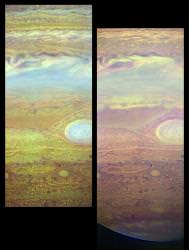 Even though New Horizon’s Jupiter flyby happened weeks ago, scientists are only just starting to crunch through the data sent back. They’re revealing better and better images of Jupiter, taken by the spacecraft’s powerful instruments. The image attached to this story was taken using New Horizon’s LEISA infrared camera. It’s a false colour photograph – not what you’d actually see if you were looking at Jupiter – but the fine details in the image are impressive.
Even though New Horizon’s Jupiter flyby happened weeks ago, scientists are only just starting to crunch through the data sent back. They’re revealing better and better images of Jupiter, taken by the spacecraft’s powerful instruments. The image attached to this story was taken using New Horizon’s LEISA infrared camera. It’s a false colour photograph – not what you’d actually see if you were looking at Jupiter – but the fine details in the image are impressive.
Continue reading “More Images from New Horizon’s Jupiter Flyby”
Double Asteroids Revealed as Twin Piles of Rubble
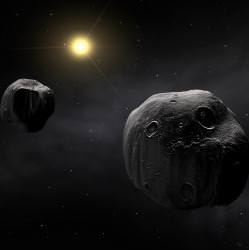 Astronomers have turned up many binary asteroids in the Solar System. Instead of a single, solitary spacerock, you’ve got two objects orbiting a common centre of gravity. A new paper published in the 2007 issue of the journal Icarus focuses on one of these double objects: the binary asteroid 90 Antiope.
Astronomers have turned up many binary asteroids in the Solar System. Instead of a single, solitary spacerock, you’ve got two objects orbiting a common centre of gravity. A new paper published in the 2007 issue of the journal Icarus focuses on one of these double objects: the binary asteroid 90 Antiope.
Continue reading “Double Asteroids Revealed as Twin Piles of Rubble”
